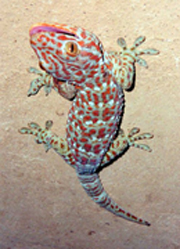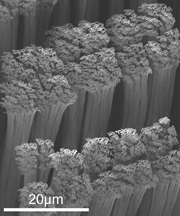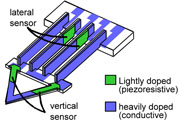| |
The gecko uses a unique and remarkable adhesive to climb smooth walls and hang from ceilings. While many species of animals can perform similar feats, the gecko adhesive architecture is special. What makes the gecko adhesive so noteworthy?
- The gecko uses a dry adhesive. Most animals use a sticky liquid to achieve adhesion. The gecko does not secrete any liquids from its feet.
- The gecko uses a relatively stiff material (beta-keratin) for its adhesive. Most pressure sensitive adhesives use a very soft material for adhesion.
- The geckos adhesive is not sticky in its default state. It is only after specific forces are applied to the adhesive that it demonstrates adhesion.
- The adhesive is capable of releasing quickly and without significant force.
Exactly how the gecko achieves this has been a subject of debate for centuries. The invention of the electron microscope allowed us for the first time to visualize the nanostructures on the geckos feet. Tiny hairs, called setae, that branch into thousands of flat submicron terminations were found on the gecko's feet. Our lab was the first to use novel micromechanical force sensors to simultaneously measure the shear and normal forces due to a single gecko hair.
Our current work on gecko tissue is focused on the effect of the seta's angular orientation on its adhesive properties. In the fabrication of gecko inspired artificial adhesives, we are collaborating with the Cutkosky lab to create adhesive structures for integration into their Stickybot platform. These artificial adhesives display gecko-like properties, making them unique. We have also measured single artificial elements and are finding that they have interesting and unexpected properties.
This work is made possible by NSF funding through the COINS grant.
To learn more about this work, please contact dsoto at stanford dot edu
Publications:
- Autumn, K., Y. A. Liang, S. T. Hsieh, W. Zesch, W.-P. Chan, W. T. Kenny, R. Fearing, and R. J. Full. 2000. Adhesive force of a single gecko foot-hair. Nature 405:681-685.
- Autumn, K., M. Sitti, A. Peattie, W. Hansen, S. Sponberg, Y. A. Liang, T. Kenny, R. Fearing, J. Israelachvili, and R. J. Full. 2002. Evidence for van der Waals adhesion in gecko setae. Proc. Natl. Acad. Sci. USA 99:12252-12256.
- A. Parness, D. Soto, N. Esparza, M. Wilkinson, N. Gravish, K. Autumn, M. Cutkosky, A microfabricated wedge-shaped adhesive array displaying gecko-like dynamic adhesion, directionality and long lifetime, Journal of the Royal Society Interface, (doi:10.1098/rsif.20090048)
- D. Soto, A. Parness, N. Esparza, M. Wilkinson, N. Gravish, K. Autumn, M. Cutkosky, Microfabricated adhesive displaying frictional adhesion, Solid-State Sensors, Actuators, and Microsystems Workshop, (Transducers Federation, Hilton Head Island, South Carolina, 2008)
- G. Hill, D. Soto, J.E. Oliver, T.W. Kenny, Characterization of dual-axis piezoresistive MEMS force sensors, Solid-State Sensors, Actuators, and Microsystems Workshop, (Transducers Federation, Hilton Head Island, South Carolina, 2008)
- G. Hill, D. Soto, S. Lu, A. Peattie, R. Full, and T.W. Kenny, Investigating the role of orientation angle on gecko setae adhesion using a dual-axis MEMS force sensor, International Conference on Solid-State Sensors, Actuators and Microsystems (Transducers Federation, Lyon, France, 2007) pp. 2263-2266.
- N. Gravish, M. Wilkinson, S. Sponberg, A. Parness, N. Esparza, D. Soto, T. Yamaguchi, M. Broide, M. Cutkosky, C. Creton, and K. Autumn, Rate dependent frictional adhesion in natural and synthetic gecko setae, Journal of the Royal Society Interface (doi:10.1098/rsif.2009.0133)
|
| |
 |
Tokay Gecko |
 |
Gecko Hairs (Setae) |
 |
Dual Axis Cantilever |
 |
Artificial Adhesive |
|



